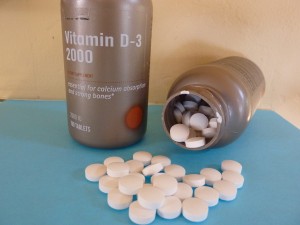
Your body produces active vitamin D3 through a series of orchestrated steps.
The natural source of vitamin D3 is the exposure of the skin to UVB radiation from the sun causing conversion of 7-dehydrocholesterol to previtamin D3 in the skin. Other sources of vitamin D include your diet or supplements.
After vitamin D3 is produced from sun exposure or ingested from a dietary source or supplement, it still requires two more steps to become active vitamin D3:
1 – The liver converts vitamin D3 to 25-hydroxy vitamin D (25OH vitamin D or calcidiol). This is the circulating storage form of vitamin D. A vitamin D blood test measures this form of vitamin D to evaluate your vitamin D status.
2 – The kidney converts 25-hydroxy vitamin D3 to active vitamin D3 (scientific name 1,25-dihyroxy vitamin D3 or calcitriol). This active form of vitamin D3 promotes bone and muscle health. Some local conversion of vitamin D also takes place outside of the kidney by the breast, prostate, colon, and other tissues to produce local concentrations of active vitamin D3.

Recommended Daily Vitamin D Intakes
The latest US guidelines released in 2010 by a scientific committee of the Institute of Medicine (IOM). The committee set new guidelines based on research evidence for support of bone health only. The guidelines increased daily values for vitamin D for all age groups based on achieving a vitamin D blood level of 20 milligrams per milliliter.
Daily recommended dietary allowance in International Units (IUs) for vitamin D by age group:
- Infants 0 to 1 year: 400
- Ages 1 to 70: 600
- Ages 70 and older: 800
Individualize Your Intake
Wide variations in vitamin D levels are common due to factors such as body size and composition, age, darker skin color, and UVB ultraviolet radiation from sun exposure. Make sure you’re getting at least the recommended dietary allowance each day. If you are carrying around extra weight (fat), more vitamin D is commonly needed. Vitamin D is stored in fat, so a larger amount is required to fill the storage area.
Take a Supplement
Since few foods contain vitamin D, either naturally or fortified, your diet may not be supplying enough vitamin D. To guarantee you are getting vitamin D, supplement your diet with vitamin D. Most multivitamins and calcium supplements contain vitamin D. Read your labels to add up your vitamin D. You still may need to take an individual vitamin D supplement to ensure you are getting adequate vitamin D.
Beyond Bone
A plethora of research has observed positive effects of vitamin D on multiple problems and diseases. Due to the observational design of the majority of these research studies, no cause and effect can be established. Clinical trials are underway to investigate the role of vitamin D in prevention of other diseases.

